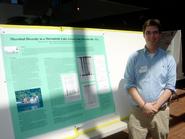
Greg Ray '08 presented a poster titled "Microbial Diversity in a Meromictic Lake, Green Lake (Fayetteville, NY)" at the Northeast Regional Undergraduate and Graduate Student Sigma Xi Poster Conference at Cornell University on April 19. Biology faculty Michael McCormick and Jinnie Garrett, and Allan Guiney '08 are co-authors of the poster.
Green Lake near Syracuse, N.Y., is one of the most well-studied examples of a meromictic lake in North America. Being meromictic means than unlike most lakes, Green Lake does not experience seasonal mixing in the water column; instead Green Lake remains permanently stratified into an oxygen rich upper layer and an anoxic lower layer. These two layers are separated by an area of sharp geochemical transition called the chemocline.
By studying the vertical distribution of unique bacterial and fungal populations in the lake the researchers can correlate microbial populations to their vertical distribution within Green Lake. In particular, this data gives useful insight into the various ecological niches within the lake and the interactions between them. In the Hamilton experiment environmental samples were collected from across the water column, cells were separated, and small subunit ribosomal DNA from these cells was amplified with taxon specific primers for subsequent analysis. Preliminary experiments using denaturing gradient gel electrophoresis (DGGE) have shown a definite correlation between the chemocline and the microbial population within Green Lake.
The Green Lake project at Hamilton began in 2006 and is funded by the Dean of Faculty's office. Sigma Xi is a scientific research honor society founded at Cornell in 1886; Hamilton has a chapter.
Green Lake near Syracuse, N.Y., is one of the most well-studied examples of a meromictic lake in North America. Being meromictic means than unlike most lakes, Green Lake does not experience seasonal mixing in the water column; instead Green Lake remains permanently stratified into an oxygen rich upper layer and an anoxic lower layer. These two layers are separated by an area of sharp geochemical transition called the chemocline.
By studying the vertical distribution of unique bacterial and fungal populations in the lake the researchers can correlate microbial populations to their vertical distribution within Green Lake. In particular, this data gives useful insight into the various ecological niches within the lake and the interactions between them. In the Hamilton experiment environmental samples were collected from across the water column, cells were separated, and small subunit ribosomal DNA from these cells was amplified with taxon specific primers for subsequent analysis. Preliminary experiments using denaturing gradient gel electrophoresis (DGGE) have shown a definite correlation between the chemocline and the microbial population within Green Lake.
The Green Lake project at Hamilton began in 2006 and is funded by the Dean of Faculty's office. Sigma Xi is a scientific research honor society founded at Cornell in 1886; Hamilton has a chapter.
Posted April 26, 2008
